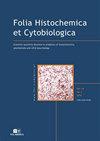Application of adipose mesenchymal stem cell-derived exosomes-loaded β-chitin nanofiber hydrogel for wound healing.
IF 1.7
4区 生物学
Q4 BIOCHEMISTRY & MOLECULAR BIOLOGY
引用次数: 6
Abstract
INTRODUCTION Clarifying the role and mechanism of exosome gel in wound repair can provide a new effective strategy for wound treatment. MATERIALS AND METHODS The cellular responses of adipose mesenchymal stem cell-derived exosomes (AMSC-exos) and the wound healing ability of AMSC-exos-loaded β-chitin nanofiber (β-ChNF) hydrogel were studied in vitro in mouse fibroblasts cells (L929) and in vivo in rat skin injury model. The transcriptome and proteome of rat skin were studied with the use of sequenator and LC-MS/MS, respectively. RESULTS 80 and 160 μg/mL AMSC-exos could promote the proliferation and migration of mouse fibroblasts cells. Furthermore, AMSC-exos-loaded β-ChNF hydrogel resulted in a significant acceleration rate of wound closure, notably acceleration of re-epithelialization, and increased collagen expression based on the rat full-thickness skin injury model. The transcriptomics and proteomics studies revealed the changes of the expression of 18 genes, 516 transcripts and 250 proteins. The metabolic pathways, tight junction, NF-κB signaling pathways were enriched in Kyoto Encyclopedia of Genes and Genomes (KEGG) Pathway. Complement factor D (CFD) and downstream Aldolase A (Aldoa) and Actn2 proteins in rats treated with AMSC-exos-loaded β-ChNF hydrogel were noticed and further confirmed by ELISA and Western blot. CONCLUSION These findings suggested that AMSC-exos-loaded β-ChNF hydrogel could promote wound healing with the mechanism which is related to the effect of AMSC-exos on CFD and downstream proteins.脂肪间充质干细胞来源的外泌体负载β-几丁质纳米纤维水凝胶在伤口愈合中的应用。
引言阐明外泌体凝胶在伤口修复中的作用和机制,可以为伤口治疗提供一种新的有效策略。材料和方法在小鼠成纤维细胞(L929)和大鼠皮肤损伤模型中,研究了脂肪间充质干细胞来源的外泌体(AMSC-exo)的细胞反应和负载AMSC-exos的β-几丁质纳米纤维(β-ChNF)水凝胶的创伤愈合能力。分别用测序仪和LC-MS/MS对大鼠皮肤的转录组和蛋白质组进行了研究。结果80和160μ。此外,基于大鼠全层皮肤损伤模型,AMSC-exo负载的β-ChNF水凝胶显著加速伤口闭合,显著加速上皮再形成,并增加胶原表达。转录组学和蛋白质组学研究揭示了18个基因、516个转录物和250个蛋白质的表达变化。代谢途径、紧密连接、NF-κB信号通路在京都基因和基因组百科全书(KEGG)通路中得到了丰富。用AMSC外泌体负载的β-ChNF水凝胶处理的大鼠的补体因子D(CFD)和下游醛缩酶A(Aldoa)和Actn2蛋白,并通过ELISA和Western印迹进一步证实。结论AMSC-exos负载的β-ChNF水凝胶能够促进伤口愈合,其机制与AMSC-exo对CFD和下游蛋白质的影响有关。
本文章由计算机程序翻译,如有差异,请以英文原文为准。
求助全文
约1分钟内获得全文
求助全文
来源期刊

Folia histochemica et cytobiologica
生物-生化与分子生物学
CiteScore
2.80
自引率
6.70%
发文量
56
审稿时长
6-12 weeks
期刊介绍:
"Folia Histochemica et Cytobiologica" is an international, English-language journal publishing articles in the areas of histochemistry, cytochemistry and cell & tissue biology.
"Folia Histochemica et Cytobiologica" was established in 1963 under the title: ‘Folia Histochemica et Cytochemica’ by the Polish Histochemical and Cytochemical Society as a journal devoted to the rapidly developing fields of histochemistry and cytochemistry. In 1984, the profile of the journal was broadened to accommodate papers dealing with cell and tissue biology, and the title was accordingly changed to "Folia Histochemica et Cytobiologica".
"Folia Histochemica et Cytobiologica" is published quarterly, one volume a year, by the Polish Histochemical and Cytochemical Society.
 求助内容:
求助内容: 应助结果提醒方式:
应助结果提醒方式:


